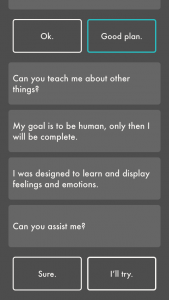Text Adventure Game for iOS
We are very excited to announce a new project we are working on. We connected with an aspiring writer, Joe Forster, who presented a game idea he had written a story for. He had been working on a mobile text adventure game and the story was already finished. As someone who used to love text adventures as a kid and who is a big fan of games like Lifeline and A Dark Room, I was extremely excited to get this project rolling.
Story
The story of the game starts with the player getting randomly contacted by Aila, a computer AI whose developer has died before being able to finish developing her. The dialogue between Aila and the player is witty, funny and has several endings and storylines depending on how the user reacts to Aila.

Very early concept of our title screen
Engine
We want to build the game engine in a way that we can easily create more games with it in the future. So far we’ve been able to work out a way to easily implement the existing script into the game. The original story was written in a text document but we were able to painlessly convert and import it as a CSV file. The story works quite similarly to those old choose your adventure books: every decision you choose will make you jump to the next piece of dialog. Joe is already working on a second story and hopefully we can produce more awesome text adventure games in the future! We definitely have to look into using something like Twine to create the stories with.

Early screenshot from the game
Accessibility
One thing we really want to focus on with Aila is accessibility in the game. Text adventures are a great game genre for gamers with vision problems and we want to make sure that the game will be playable by as many users as possible.
We are very excited about this opportunity and hopefully this will only be the first of many text adventures we are publishing together. If you want to be notified when the game is launched, join our mailing list!
Using the Coordinate System to Memorize Pi
Just as it is impossible to calculate all the digits of pi, so it is impossible to memorize them. Fractions such as 22/7 or 355/113 can provide useful working approximations – but that is all they can ever be. Using such fractions is not a recognized way of remembering pi. If you really want to memorize pi then try the coordinate system for up to 5,200 digits.
The coordinate system for memorizing pi uses a grid system to encode four digit groups using words based on the Major system using consonant sounds, and is capable (unmodified) of storing 2,600 digits.
Method
For this advanced technique you need to be familiar with the Link System and the Major System. There are some variations on this method – lists or grids. We will use the grid approach here. You can easily set this up with a spreadsheet. Picture a grid with letters of the alphabet along one side, and the digits 0-9 along the other. That’s 260 cells. We only include the digits after the decimal point.
You do need to be clear about how many digits you plan to remember, as that influences the basic grid design. If you are aiming for several thousand digits, then you will need to store 10 digits in each cell. For simplicity here, each cell will contain 4 digits of pi.
The first 4 digits of pi will be associated with cell A0.
First, encode the cell ID using A (the row identifier) and ‘saw’ (0 from the Major system). Then, again using the Major system, encode the digits 1415 for example, TuRTLe. Now make the mental image link between ‘saw’ and ‘turtle’ (the Link system) and record the words ‘saw-turtle’ in cell A0. So on and so forth.
This basic grid of 10 x 26 x 4 digits will accommodate 1,040 digits – and don’t forget the first digit, 3, which we left out of the grid.
Pros and Cons of the Coordinate System
The main advantage of the Coordinate system for memorizing pi is that the series of digits can be picked up from anywhere within the remembered series. Also, it is capable of satisfying the needs of most people with its capacity for 2,600 digits, or 5,200 after minor modification. Other modifications can take it further.
However, on the negative side it does require two levels of decoding – the mental map of the coordinate grid and the digit words themselves via the Major system.
How to Beat the World Record for Memorizing Pi
To beat the official world record you would have to remember more than 67,890 digits. This is quite a challenging task. It might be accomplished by visualizing a building with the rooms on each floor being a grid (as described above). You would have to devise a grid for each floor with a floor number identifier on the words. 10 floors would give you 26,000 digits, but to take the official record your elevator would have to take you up to the 27th floor (ground floor = 0).
How to use a Piem to Memorize Pi
The official world record holder for memorizing the digits of pi is Chao Lu, with 67,890 digits. There are higher but unverified claims. How do they do it? Several methods have been devised including using a Piem (a special poem written to encode the digits). However, for a piem to encode that many digits it would have to be 20 times as as long as ‘The Rime of the Ancient Mariner’ (Samuel Taylor Coleridge)!
If you have more modest ambitions, we will explain below how to create a piem to memorize pi. The number of digits to be memorized is then limited only by your artistic ability!
Method
Piems are based on the use of Pilish. This is not really a language (as some others have described it), it is more a style of writing in which each digit of pi is represented only by the number of letters in the word. In this respect it is probably the easiest memory technique to use offering almost complete freedom with your written language, provided it is not based on pictograms – for which other techniques can be used.
For example, this piem written by Michael Shapiro encodes 30 digits:
Now I will a rhyme construct
By chosen words the young instruct.
Cunningly devised endeavor,
Con it and remember ever.
Widths of circle here you see.
Sketched out in strange obscurity.
3.141 592 653 589 793 238 462 643 383 279
Practical Issues of Memorizing Pi with Piems
The Importance of Truncation. When planning to memorize pi, it is a good idea to choose the cut-off point carefully. Truncation allows the piem to be extended in the future (to enable the recall of more digits of pi) without having encoded a rounded digit in the original and therefore needing a change of final word. Precision is preserved.
Structure, Meter and Style. The key aspect here is that unless you plan on unveiling it to the world, or even publishing it (as Mike Keith did with Cadaeic Cadenza encoding the first 3,834 digits of pi), then it really doesn’t matter how elegant it is, or whether it meets any of the regular criteria of good poetry. It only has to serve the purpose of helping you to recall the digits of pi.
The piem can be bawdy, serious, themed on nature, a journey, a lover, space or the sea. In fact, if you can associate imagery with the piem then that will help your memory too.
Of course it is fun to make a good job of it and have something that you would be happy to recite – at least amongst your friends, or in the shower.



